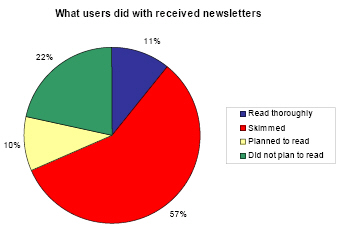A guide to email newsletters and RSS usability

Jakob Nielsen and Amy Schade of the Nielsen Norman Group just published a 544-page study on email newsletter usability, including 165 guidelines for subscriptions, content, managing accounts and RSS-based news feeds. It’s the third edition of the study, which the company has done about every two years so far.
One of the major findings was that users in the study spent 51 seconds on average scanning a newsletter, Nielsen told me. “The 51 seconds in extraordinarily valuable in forming a relationship with customer,” he said. Email overload is obviously a factor in email newsletter performance. “In the field study, watching people at their offices, it was more clear than ever that processing email is a somewhat stressful scenario. People scan the inbox list in quite a brutal manner. If they don’t think it’s worthwhile or spam, they delete it. If they open it, they spend a small amount of time on it.”

The best newsletters are specialized the receivers needs, timely, short and scannable and arrive on a predictable schedule, Nielsen said. “We also used eye-tracking, and found that only 19 percent, down from 23 percent in the first study, of people read the entire newsletter. The ability to pick out what you want is a tough criteria for newsletters to be of value.” The dominant consumption mode for email newsletters is skimming. In the study 69 percent of the newsletter read by the participants were skimmed, hence the 51 second average “reading” time.
The study also found that more mainstream users are using multiple email accounts, and carefully select which email address to give out based on how likely they would get spammed or how credible the source. Of course, the goal for any newsletter creator is to get into the primary inbox. With desktop search usage growing, using keywords that will ensure newsletters show up in search results is important, Nielsen said. “In the B2B space, they tend to use their own vocabulary to describe their services, when they should be using more straightforward language.”
Nielsen’s recommendation on RSS news feeds is to stop call them “RSS.” In the study, 82 percent of users had no clue what RSS meant. “Call it feeds or new feeds is more self explanatory,” Nielsen said. He also noted that the first two words in the headline are key. “The fixation is on the first two word. It’s often all you get to capture a user’s interest, and get them to read the rest of the line and then the blurb. You live or die by those two words.”
Users in the study had mixed feelings about feeds. Some people liked viewing information from multiple sites in a single centralized location, but for others perceived feeds as more information overload. “Feeds are a cold medium in comparison with email newsletters. Feeds don’t form the same relationship between company and customers that a good newsletter can build,” the report said. “For the blogger demographic or early adopter news feeds are desired, but for business managers or soccer moms, the broad consumer audience, newsletters are preferable," Nielsen said.
A single copy costs of the "Email Newsletter Usability" study costs $398. The free executive summary is available here.